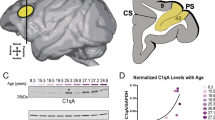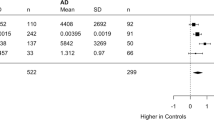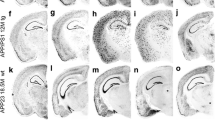Abstract
The levels and cellular localization of mRNA for complement C1q and C3 were examined by RNA gel blot and nonradioactive in situ hybridization in the frontal cortex of patients with Alzheimer's disease (AD) and age-matched controls. We found that the hybridization signal for C1q mRNA was markedly increased (approx. 3.5-fold) in the frontal cortex of AD patients compared to that in age-matched controls. In contrast to previous reports we also found that the levels of C3 mRNA, although well expressed, did not differ significantly between AD cases and age-matched controls. Nonradioactive in situ hybridization using digoxigenin-labeled riboprobes revealed that transcripts coding for both C1q and C3 were closely associated with neurons. These results support the hypothesis that complement could play a role in neuronal degeneration which has been observed in the brain of AD patients.
Similar content being viewed by others
Abbreviations
- SDAT :
-
Senile dementia of Alzheimer type
- AD :
-
Alzheimer disease
- IL :
-
Interleukin
References
Ahrenstedt O, Knutson L, Nilsson B, Nilsson-Ekdahl K, Odlind B, Hallgren R (1990) Enhanced local production of complement components in the small intestines of patients with Crohn's disease. N Engl J Med 322:1345–1349
Akiyama H, Kawamata T, Dedhar S, McGeer PL (1991) Immunohistochemical localization of vitronectin, its receptor and beta-3 integrin in Alzheimer brain tissue. J Neuroimmunol 32:19–28
Ausubel FM, Brent R, Kingston RE, Moore DD, Seidman JG, Smith JA, Struhl K (1992) Short protocols in molecular biology, 2nd edn. Wiley, New York
Bauer J, Strauss S, Schreiter-Gasser U, Ganter U, Schlegel P, Witt I, Yolk B, Berger M (1991) Interleukin-6 and α-2-macroglobulin indicate an acute-phase state in Alzheimer's disease cortices. FEBS Lett 285:111–114
Blessed G, Tomlinson BE, Roth M (1968) The association between quantitative measures of dementia and of senile change in the cerebral grey matter of elderly subjects. Br J Psychiatry 114:797–811
Cammer W, Brosnan CF, Basile, C, Bloom, BR and Norton, WT (1986) Complement potentiates the degradation of myelin proteins by plasmin: Implications for a mechanism of inflammatory demyelination. Brain Res 364:91–101
Chomczynski P, Sachi, N (1987) Single-step method of RNA isolation by acid guanidinium thiocyanate-phenol-chloroform extraction. Anal Biochem 162:156–159
Compston A, Scolding N, Wren D, Noble M (1991) The pathogenesis of demyelinating disease: insights from cell biology. Trends Neurosci 14:175–182
Cyong J-C, Witkin SS, Rieger B, Barbarese E, Good RA, Day NK (1982) Antibody-independent complement activation by myelin via the classical complement pathway. J Exp Med 155:587–598
Davies CA, Mann DMA, Sumpter PW, Yates PO (1987) A quantitative morphometric analysis of the neuronal and synaptic content of the frontal and temporal cortex in patients with Alzheimer's disease. J Neurol Sci 78:151–164
Davies A, Simmons DL, Hale G, Harrison RA, Tighe H, Lachmann PJ, Waldmann H (1989) CD59, an Ly-6-like protein expressed in human lymphoid cells, regulates the action of the complement membrane attack complex on homologous cells. J Exp Med 170:637–654
DeKosky, ST, Scheff SW (1990) Synapse loss in frontal cortex biopsies in Alzheimer's disease: correlation with cognitive severity. Ann Neurol 27:457–464
Eikelenboom P, Stam FC (1982) Immunoglobulins and complement factors in senile plaques. Acta Neuropathol (Berl) 57:239–242
Eikelenboom P, Hack CE, Rozemuller JM, Stam F (1989) Complement activation in amyloid plaques in Alzheimer's dementia. Virchows Arch B Cell Pathol 56:259–262
Giulian, D (1993) Reactive glia as rivals in regulating neuronal survival. Glia 7:102–110
Gordon DL, Avery VM, Adrian DL, Sadlon TA (1992) Detection of complement protein mRNA in human astrocytes by the polymerase chain reaction. J Neurosci Methods 45:191–197
Gordon DL, Sadlon TA, Wesselingh SL, Russell SM, Johnstone RW, Purcell DFJ (1992) Human astrocytes express membrane cofactor protein (CD46) a regulator of complement activation. J Neuroimmunol 36:199–208
Gordon DL, Sadlon T, Hefford C, Adrian D (1993) Expression of CD59, a regulator of the membrane attack complex of complement, on human astrocytes. Mol Brain Res 18:335–338
Griffin WST, Stanley LC, Ling C, White L, MacLeod V, Perrot LJ, White CL, Araoz C (1989) Brain interleukin 1 and S- 100 immunoreactivity are elevated in Down syndrome and Alzheimer disease. Proc Natl Acad Sci USA 86:7611–7615
Haga S, Ikeda K, Sato M, Ishii T (1993) Synthetic Alzheimer amyloid β/A4 peptides enhance production of complement C3 component by cultured microglial cells. Brain Res 601:88–94
Hamos J, DeGennaro L, Drachman D (1989) Synaptic loss in Alzheimer's disease and other dementias. Neurology 39:355–361
Holguin MH, Frederick LR, Brenshaw NJ, Wilcox LA, Parker CJ (1989) Isolation and characterization of a membrane protein from normal human erythrocytes that inhibit reactive lysis of the erythrocytes of paroxysmal nocturnal hemoglobinuria. J Clin Invest 84:7–17
Ishii T, Haga, S (1984) Immuno-electron microscopic localization of complements in amyloid fibrils of senile plaques. Acta Neuropathol 63:296–300
Jiang H, Siegel JN, Gewurz H (1991) Binding and complement activation by C-reactive protein via the collagen-like region of C1q and inhibition of these reactions by monoclonal antibodies to C-reactive protein and C1q. J Immunol 146:2324–2330
Johnson SA, Lampert-Etchells M, Pasinetti, GM, Rozovsky I, Finch, CE (1992) Complement mRNA in the mammalian brain: Responses to Alzheimer's disease and experimental brain lesioning. Neurobiol Aging 13:641–648
Kawamata T, Akiyama H, Yamada T, McGeer PL (1992) Immunologic reactions in amyotrophic lateral sclerosi brain and spinal cord tissue. Am J Pathol 140:691–707
Krensky AM, Weiss A, Crabtree G, Davis MM, Parham P (1990) T-lymphocyte-antigen interactions in transplant rejection. N Eng J Med 322:510–517
Liu, WT, Vanguri, P, Shin, ML (1983) Studies on demyelination in vitro: the requirement of membrane attack components of the complement system. J Immunol 131:778–782
Lublin DM, Atkinson JP (1990) Decay-accelerating factor and membrane cofactor protein. Curr Top Microbiol Immunol 153:123–145
Luber-Narod J, Rogers J (1988) Immune system associated antigens expressed by cells of the human central nervous system. Neurosci Lett 94:17–22
Masliah E, Terry RD, Alford M, DeTeresa R, Hansen LA (1991) Cortical and subcortical patterns of synaptophysin-like immunoreactivity in Alzheimer's disease. Am J Pathol 138:235–246
Masliah E, Terry R, DeTeresa R, Hansen L (1989) Immuno-histochemical quantification of the synapse-related protein synaptophysin in Alzheimer disease. Neurosci Lett 103:234–239
McDonald B, Esiri MM, McIlhinney RAJ (1991) A monoclonal antibody that reacts immunohistochemically with amyloid deposits in the brain tissue of Alzheimer patients binds to an epitope present on complement factor 4. J Neurochem 57:1172–1177
McGeer PL, Akiyama H, Itagaki S, McGeer EG (1989) Immune system response in Alzheimer's disease. Can J Neurol Sci 16:516–527
McGeer PL, Akiyama H, Itagaki S, McGeer EG (1989) Activation of the classical complement pathway in brain tissue of Alzheimer patients. Neurosci Lett 107:341–346
McGeer PL, Walker DG, Akiyama H, Kawamata T, Guan AL, Parker CJ, McGeer EG (1991) Detection of the membrane inhibitor of reactive lysis (CD59) in diseased neurons of Alzheimer brain. Brain Res 544:315–319
McGeer PL, Kawamata T, Walker DG, Akiyama H, Tooyama I, McGeer EG (1993) Microglia in degenerative neurological disease. Glia 7:84–92
Okada N, Harada N, Fujita R, Okada H (1989) Monoclonal antibodies capable of causing hemolysis of neuraminidase-treated human erythrocytes by homologous complement. J Immunol 143:2262–2266
Passwell JH, Schreiner GF, Wetsel RA, Colten HR (1990) Complement gene expression in hepatic and extrahepatic tissues of NZB and NZBxW (F1) mouse strains. Immunology 71:290–294
Perry VH, Anderson PB (1992) The inflammatory response in the CNS. Neuropathol Appl Neurobiol 18:454–459
Rogers J, Cooper NR, Webster S, Schultz J, McGeer PL, Styren SD, Civin WH, Brachova L, Bradt B, Ward P, Lieberburg I (1992) Complement activation by β-amyloid in Alzheimer's disease. Proc Natl Acad Sci USA 89:10016–10020
Rus HG, Kim LM, Niculescu FI, Shin ML (1992) Induction of C3 expression in astrocytes is regulated by cytokines and Newcastle virus. J Immunol 148:928–933
Scheff SW, Price DA (1993) Synapse loss in the temporal lobe in Alzheimer's disease. Ann Neurol 33:190–199
Scheff SW, DeKosky ST, Price DA (1990) Quantitative assessment of cortical synaptic density in Alzheimer's disease. Neurobiol Aging 11:29–37
Schultz J, Schaller J, McKinley M, Bradt B, Cooper N, May P, Rogers J (1994) Enhanced cytotoxicity of amyloid β-peptide by a complement dependent mechanism. Neurosci Lett 175:99–102
Shirazi Y, Imagawa DK, Shin ML (1987) Release of leukotriene B4 from sublethally injured oligodendrocytes by terminal complement complexes. J Neurochem 48:271–278
Strauss B, Bauer J, Ganter U, Jonas U, Berger M, Volk B (1992) Detection of interleukin-6 and α2-macroglobulin immunoreactivity in cortex and hippocampus of Alzheimer's disease patients. Lab Invest 66:223–230
Terry RD, Masliah E, Salmon DP, Butters N, DeTeresa R, Hill R, Hansen LA, Katzman R (1991) Physical basis of cognitive alterations in Alzheimer's disease: synapse loss is the major correlate of cognitive impairment. Ann Neurol 30:572–580
Vanguri P, Shin ML (1988) Hydrolysis of myelin basic protein in human myelin by terminal complement complexes. J Biol Chem 263:7228–7234
Vanguri P, Koski CL, Silverman B, Shin ML (1982) Complement activation by isolated myelin: activation of the classical pathway in the absence of myelin-specific antibodies. Proc Natl Acad Sci USA 79:3290–3294
Walker D, McGeer PL (1992) Complement gene expression in human brain: comparison between normal and Alzheimer disease cases. Mol Brain Res 14:109–116
Widner H, Brundin P (1988) Immunological aspects of grafting in the mammalian central nervous system. A review and speculative synthesis. Brain Res Rev 13:287–324
Wood JA, Wood PL, Ryan R, Graff-Radford NR, Pilapil C, Robitaille Y, Quirion R (1993) Cytokine indices in Alzheimer' temporal cortex: no changes in mature IL-1β or IL-1RA but increases in the assocuated acute phase proteins IL-6, α2-macroglobulin and C-reactive protein. Brain Res 629:245–252
Author information
Authors and Affiliations
Rights and permissions
About this article
Cite this article
Fischer, B., Schmoll, H., Platt, D. et al. Complement C1q and C3 mRNA expression in the frontal cortex of Alzheimer's patients. J Mol Med 73, 465–471 (1995). https://doi.org/10.1007/BF00202265
Received:
Accepted:
Issue Date:
DOI: https://doi.org/10.1007/BF00202265




